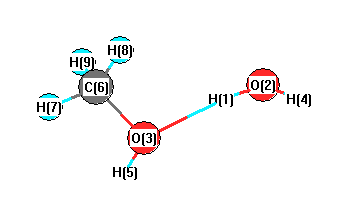Vibrational Frequencies calculated at CCSD(T)/6-31G*
| Mode Number |
Symmetry |
Frequency
(cm-1) |
Scaled Frequency
(cm-1) |
IR Intensities
(km mol-1) |
Raman Act
(Å4/u) |
Dep P |
Dep U |
|---|
| 1 |
A |
3826 |
3681 |
|
|
|
|
| 2 |
A |
3735 |
3593 |
|
|
|
|
| 3 |
A |
3683 |
3543 |
|
|
|
|
| 4 |
A |
3165 |
3045 |
|
|
|
|
| 5 |
A |
3118 |
3000 |
|
|
|
|
| 6 |
A |
3046 |
2930 |
|
|
|
|
| 7 |
A |
1774 |
1707 |
|
|
|
|
| 8 |
A |
1549 |
1490 |
|
|
|
|
| 9 |
A |
1542 |
1483 |
|
|
|
|
| 10 |
A |
1514 |
1457 |
|
|
|
|
| 11 |
A |
1411 |
1358 |
|
|
|
|
| 12 |
A |
1192 |
1147 |
|
|
|
|
| 13 |
A |
1094 |
1052 |
|
|
|
|
| 14 |
A |
1059 |
1019 |
|
|
|
|
| 15 |
A |
633 |
609 |
|
|
|
|
| 16 |
A |
484 |
465 |
|
|
|
|
| 17 |
A |
287 |
276 |
|
|
|
|
| 18 |
A |
197 |
190 |
|
|
|
|
| 19 |
A |
134 |
129 |
|
|
|
|
| 20 |
A |
93 |
89 |
|
|
|
|
| 21 |
A |
67 |
65 |
|
|
|
|
Unscaled Zero Point Vibrational Energy (zpe) 16799.7 cm
-1
Scaled (by 0.9621) Zero Point Vibrational Energy (zpe) 16163.0 cm
-1
See section
III.C.1 List or set vibrational scaling factors
to change the scale factors used here.
See section
III.C.2
Calculate a vibrational scaling factor for a given set of molecules
to determine the least squares best scaling factor.
Charges, Dipole, Quadrupole and Polarizability
Charges from optimized geometry at CCSD(T)/6-31G*
Charges (e)
| Number |
Element |
Mulliken |
CHELPG |
AIM |
ESP |
| 1 |
H |
0.478 |
|
|
|
| 2 |
O |
-0.924 |
|
|
|
| 3 |
O |
-0.750 |
|
|
|
| 4 |
H |
0.423 |
|
|
|
| 5 |
H |
0.448 |
|
|
|
| 6 |
C |
-0.192 |
|
|
|
| 7 |
H |
0.158 |
|
|
|
| 8 |
H |
0.181 |
|
|
|
| 9 |
H |
0.179 |
|
|
|
Electric dipole moments
Electric dipole components in Debye
(What's a Debye? See section
VII.A.3)
| |
x |
y |
z |
Total |
| |
1.905 |
-0.229 |
0.285 |
1.940 |
| CHELPG |
|
|
|
|
| AIM |
|
|
|
|
| ESP |
|
|
|
|
Electric Quadrupole moment
Quadrupole components in D Å
Polarizabilities
Components of the polarizability tensor.
Units are
Å
3 (Angstrom cubed)
Change units.
| |
x |
y |
z |
| x |
0.000 |
0.000 |
0.000 |
| y |
0.000 |
0.000 |
0.000 |
| z |
0.000 |
0.000 |
0.000 |
<r2> (average value of r
2) Å
2
| <r2> |
86.498 |
| (<r2>)1/2 |
9.300 |
